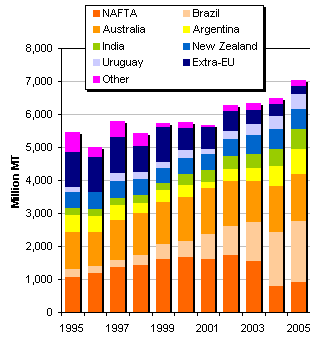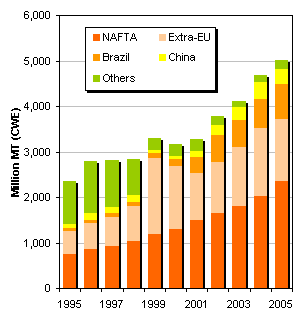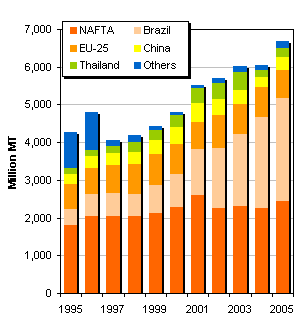|
North American animal agriculture has undergone dramatic changes during the past two decades. Among the most important is the increased degree of market integration among all three NAFTA countries. Prices and trade flows are increasingly impacted by events, policies, and forces outside the continent. Global animal product markets are consumer-driven with product safety, wholesomeness, quality, and price being key determinants of international competitiveness. Processors, retailers, and food service corporations are expanding and integrating this global market, bringing efficiency and lower-cost food to both developed and developing countries around the world.
This article draws on a much longer report, The Future of Animal Agriculture in North America (Farm Foundation, 2006). Sources for figures and charts cited can be found in that report.
Three key global forces will shape the future of North American animal and product trade: animal disease outbreaks and discoveries, income growth in developing economies, and trade liberalization. Impacts of disease outbreaks, such as high-pathogenic avian influenza, have certainly disrupted trade in poultry meat and could have longer term consequences affecting consumption in some countries. Diseases such as bovine spongiform encephalopathy (BSE) may cause structural change in the industry. Consumer income growth in the United States and other developed countries has slowed, as has the growth rate in consumption of most animal products. In developing countries, however, there is a strong linkage between increased demand for animal proteins and consumer income growth. Expanded trade can also result from multilateral trade negotiations in the World Trade Organization (WTO) that reduce the effects of trade-distorting domestic policies used by developed countries, and result in much lower tariffs in developing countries and more consistently applied and science-based sanitary and phytosanitary (SPS) product standards.
North America is both a leading exporter and importer of animal products. The European Union (EU) is a larger exporter, but most of that trade is intra-EU. While Canada and the United States are important markets for each other's animal products, they also compete for export markets. Brazil is a rapidly growing export competitor in poultry, but competes less directly in beef and pork. China and Russia have significant potential as export customers, but inconsistent SPS regulations and policies have impeded the development of these markets.
Worldwide, demand for North American animal products is likely to continue to grow if consumer incomes rise and trade barriers are lowered. Meanwhile, both governments and the private sector face increasing pressure to assure consumers of product safety and quality. Market institutions, such as the World Organization for Animal Health, that help harmonize SPS regulations, may lessen the confusion about trading rules and facilitate more trade opportunities.
Beef and Beef Cattle Trade
Among the most significant trends in the North American cattle industry during the past 25 years has been the growth of the Canadian and Mexican cattle and beef markets relative to that of the United States. The period from 1980 to 1985 marked the high point for the U.S. beef cattle inventory, relative to Canada and Mexico; the number of U.S. cattle has trended downward ever since. During that same period, Mexican and Canadian beef cattle numbers increased.
Historically, North America has accounted for nearly 25% of world beef exports in retail weight equivalent, and 50% of that trade was intra-NAFTA (Figure 1). The BSE incident in 2003, however, reduced NAFTA's world beef market share to 13% in 2005 and increased intra-NAFTA beef trade to 95%. Before the BSE case was identified in Canada in May 2003, 85% to 90% of Canadian beef exports were shipped to the United States and Mexico. For a period of months after the BSE incident, Canadian beef exports virtually stopped due to complete import bans by major customers.
Primary markets for U.S. beef exports before the BSE scare were Japan, Korea, and Mexico, accounting for about 80% of the total, with a smaller amount going to Canada. Post-BSE, the majority of U.S. beef exports are destined for Mexico and Canada. With Japan and Korea reopening their markets to U.S. beef, there is some optimism that a large share of those markets will be recaptured, but the United States is facing significant competition for those markets from other exporters, including Australia.
North America accounted for 42% of world beef imports in 2005, a level similar to that of the past five years. The United States accounted for about 81% of North American beef imports in 2005, Mexico 14%, and Canada 5%. The large U.S. share is due in part to a slight rise in U.S. beef demand, lower beef supplies, and more imports of beef trimmings to service the ground meat and fast-food markets.
Brazil has become a major beef trader, with exports of 1.1 million metric tons (mmt) in 2004 and 1.3 mmt in 2005, compared to 178 thousand metric tons (tmt) in 1996. Brazil's major export markets are the Middle East, the EU, and Russia. Other major beef exporters include Australia and New Zealand, which on average have exported a combined 1.3 mmt during the past five years, mainly to the United States, Japan, Korea, Taiwan, and Canada.
Before 2004, the main competitor for U.S. beef in the Japanese market was Australia. U.S. exports captured about 47% of the volume of the Japanese beef import market and Australia 45%. U.S. beef sells at a premium because it is grain-fed beef, which is generally considered to be of higher quality than the predominantly leaner, grass-fed Australian beef.
The United States dominated the Korean market prior to the BSE scare, typically capturing more than 65% of the market. Australia and New Zealand have both been able to increase beef exports to Korea following the ban on U.S. beef.
Mexico typically buys more than 90% of its imported beef from the United States and Canada, with U.S. beef dominating. Mexico mainly imports U.S. boneless beef, as well as about one-third of all U.S. beef offal exports.
The United States has more recently imported significant amounts of beef. Australia and Canada each typically account for 30% to 40% of total imports, with New Zealand in the 20% to 30% range. U.S. beef imports have increased due to more beef demand spurred by the low-carbohydrate diets and the popularity of fast-food.
Hog and Pork Trade
The most significant North American hog trend during the past 25 years is growth in the size of the Canadian hog herd relative to that of the United States. The period from 1990 to 1995 marked the high point for the U.S. hog inventory when compared to Canada and Mexico. The North American industry has become more efficient in producing pigs as the sow inventory has declined, while the pig crop continues to increase.
In 2005, Canada exported 812 tmt of pork, and the United States exported 907 tmt (Figure 2). About 750 tmt of the 1.8 mmt in North American pork exports were to NAFTA partners. Since 1995, more than half of Mexico's imports have come from the United States and Canada. Canada's main export market has been the United States and Japan. In 2005, the major U.S. export markets were Japan (343 tmt), Mexico (202 tmt), and Canada (113 tmt). The main competition for North American pork in the Japanese market is the EU, which exports slightly more than the United States or Canada. U.S. exports captured about 30% of the Japanese market, Canada 20%, and the EU 40%.
Following the implementation of the Canada-United States Free Trade Agreement (CUSFTA), Canadian exports of live hogs to the United States increased to 8.2 million head in 2005 from 1.1 million head in 1989. Canada accounts for all but a few hundred head of U.S. hog imports. North American live hog trade is more than 75% of world hog trade. Since 1995, Canadian exports of fed hogs to the United States have grown to 2.9 million head from 1.1 million head. Even more dramatic growth has occurred in U.S. imports of feeder pigs from Canada, increasing from 700,000 head to 5.6 million head over the same period. Canadian finishing capacity is limited when compared to advances in farrowing capacity and efficiency. The U.S. pork industry has a comparative advantage in hog finishing due to lower feed prices and lower transport costs of finished hogs to slaughter facilities. As a result, increased trade in live hogs between the United States and Canada has spurred the development of a well-integrated North American pork industry.
Poultry Trade
North America accounted for 35% of the 63.6 mmt world poultry meat production in 2005, down from a high of 39% in 1995 (Figure 3). The main reason for the decline in North American global market share was a 12.2 mmt increase in Chinese and Brazilian production combined. These increases are substantially more than the 7.7 mmt increase in poultry meat production that North America experienced during the same period. The other leading world supplier is the EU, producing 9.6 mmt in 2005, up 61% from 1990. Broiler meats account for 92% of world poultry meat production, up from 89% in 1990.
North American countries accounted for one-third of world poultry meat consumption in 2005 (19.9 mmt). Chinese and EU poultry meat consumption is balanced with production. North American and Brazilian production exceeds consumption by 2.1 mmt and 2.9 mmt, respectively.
Brazil has increased poultry meat exports by taking advantage of favorable exchange rates, disease outbreaks in other exporting countries, sanitary negotiations with Asian countries, and aggressive market promotion. Brazil is cost efficient in poultry production, but has limited transportation infrastructure. In 2005, Brazil and the United States exported 2.9 mmt and 2.6 mmt of poultry meat, respectively. The United States has a 36% market share of world poultry meat exports, Brazil 40%, and the EU, excluding intra-EU trade, 11%.
Historically, the majority of U.S. poultry exports have gone to Russia, China/Hong Kong, and Mexico. While Russia and Mexico have remained consistent markets during the past decade, China/Hong Kong began decreasing imports of U.S. poultry in 1999, when it was the largest market for U.S. exports. Ukraine, Turkey, Cuba, Lithuania, and Japan are important poultry meat export markets for the United States, as well.
Milk and Dairy Products Trade
North American milk production was 98.1 mmt in 2005, compared to total world output of 483.7 mmt. The United States is the world's largest single country producer of cow's milk and accounts for 82% of North American milk output. Mexico produces 10.2%, and Canada 7.9%. During the past two decades, Mexican milk production has increased by 40%, while the output of the United States grew 23.6% and Canada declined 1.2%. These increases in output have generally come from fewer cows, except in Mexico where extensive dual-purpose production systems still predominate.
The EU makes up 75% of world dairy trade, followed by New Zealand and Australia. Most EU dairy exports are intra-EU, with only an estimated 16% of exports sold to non-EU countries. North America dairy exports totaled only 900 tmt in 2004, with the United States accounting for 75% of these shipments. U.S. dairy product exports were shipped to a large number of countries, including Mexico and Canada, in 2004. After removing intra-EU dairy exports, New Zealand was the largest single-country exporter, with nearly 15% of the world's total.
North America imported only 7.3% of the world's total volume of dairy imports in 2003. Of that, Mexico accounted for 48%, the United States 38%, and Canada 13%. World dairy product import volumes have increased by more than 50%, growing to 75.6 mmt in 2003 from 50.0 mmt in 1985. New Zealand has continued to increase dairy product exports and may be reaching its capacity to expand its dairy cattle herd. New Zealand simply may not have enough land area to further increase its dairy herd and milk output.
Strategies and Implications
Several strategies to increase the global competitiveness of North American animal industries emphasize the importance of economic growth in developing countries and the importance of having access to those potential markets. Others focus on ways to mitigate the negative impacts of animal disease outbreaks. The final two strategies emphasize the importance of industry efficiency and the need for regulatory consistency to enhance the overall competitiveness of the industry.
- Consumer income growth in developing countries may be the single most important factor in increasing North American meat exports during the next decade. The long-term payoff for the industry of policies aimed at growing the economies of developing countries is likely to be quite high. Such policies may be controversial since some may be aimed at improving the productive capacity of agriculture in the developing world as a first step in raising consumer incomes, because a large share of the population is employed in production agriculture. This strategy worked with four customers for North American animal products—Japan, Korea, Mexico, and Taiwan. However, improving agriculture in developing countries will be viewed by some industry participants as creating competitors.
- Brazil, and to a lesser extent its neighbors, is likely to remain a major force in world animal product trade. Brazil, in fact, may continue to increase its share of beef and poultry markets during the next decade. But periodic outbreaks of Foot-and-Mouth Disease, should they occur, will limit this potential. However, if Brazil's per-capita income grows fast enough, a large proportion of its increasing production will be absorbed internally rather than abroad. Further, pursuit of a Free Trade Area of the Americas (FTAA) or other regional agreements will give the NAFTA countries the opportunity to integrate markets with Brazil, Argentina, Paraguay, and Uruguay within the MERCOSUR trading bloc. As has been learned from NAFTA, dealing with trade disputes and issues of competition within an established framework is often more productive.
- To maintain and improve the efficiency of the North American animal industry, greater harmonization of policies, programs, and regulations among countries is required. This may include, but is not limited to, animal and plant health, farm programs, environmental regulations, product safety, and animal identification rules. Regular meetings of NAFTA country agricultural and food agencies and legislative policymakers to discuss regulations and rule making may help improve transnational harmonization, but requires a commitment on the part of these groups to achieve a greater degree of policy harmonization as a means to increase efficiency of the entire North American industry.
- While it is important to mitigate the real risks of animal diseases, one of the greatest potential barriers to international trade in animal products is the perceived risk of such events. The temporary repercussions of short-term actions against another country's products may become permanent obstacles. Implications include the need for adherence to science-based principles, improved traceability from farm or feedlot to the consumer, and enhanced regulatory coordination among NAFTA countries.
- Large supplies of inexpensive feeds creating production efficiencies have been a major factor in the growth of animal product exports from the United States and Canada. However, changes in policy as a result of WTO commitments or budgetary pressures that reduce feed production incentives may serve to reduce the competitive advantage held by North America through increased raw commodity prices. Increased ethanol and bio-diesel production may further increase feed costs. To offset this, the development of new technologies and increased efficiency are important to maintain the competitiveness of the North American animal agriculture industry.
- Future growth in animal product trade will depend on industry success in creating branded/packaged, value-added products because local processing capacity in many developing countries is limited. Tapping into these markets will require creative marketing and packaging and will retain the value-added components within North America. To enhance the competitiveness of the products, government regulators and trade negotiators need to work closely with the food manufacturing and food service industries to assure a sound policy and regulatory framework to support future trade growth.
North American trade in live animals is largely intra-NAFTA, while trade in animal products relies on markets outside NAFTA. The North American livestock industry's future, therefore, is at least partly reliant on the competitiveness of meats and animal by-products production and trade. The extent to which the industry can compete globally will be shaped by the ability of the industry to mitigate the effects of animal disease outbreaks and discoveries, consumer income growth in developing countries, and the success of trade liberalization efforts to open markets and develop more consistent SPS regulations with current and future trading partners.
For More Information
Diakosavvas, D. (1995). How integrated are world beef markets? The case of Australian and U.S. beef markets. Agricultural Economics, 12(1) , 37-53.
Farm Foundation (2006). The future of animal agriculture in North America. Available online: http://www.farmfoundation.org. Oak Brook, IL.
Foreign Agricultural Service (FAS), USDA. (1995-2005). FAS Agricultural Attaché Reports Section. Reports for Livestock, Poultry, and Products, selected issues, 1995 to 2005. Available online: http://www.fas.usda.gov/scriptsw/attacherep/default.asp.
Hahn, W.F., Haley, M., Leuck, D., Miller, J.J., Perry, J., Taha, F., & Zahniser, S. (2005, May). Market integration of the North American animal products complex. Electronic Outlook Report from the Economic Research Service, USDA. Report No. LDP-M-131-01. Available online: http://www.ers.usda.gov/Publications/ldp/may05/ldpm13101/.
Market integration of the North American animal products complex. (2005). Available online: http://www.ers.usda.gov/publications/ ldp/may05/1dpm/13101/ldpm13101.pdf.
Regmi, A., & Gehlhar, M. (2005, February). New directions in global food markets. Agriculture Information Bulletin No. AIB794. Available online: http://www.ers.usda.gov/publications/aib794/.
Rosson, C. Parr, & Adcock, F.J. (2005, July). Food chain disruptions and trade: The importance of North American market integration. Choices, 2nd Quarter, 20(2), 149-155 (in pdf version). On-line journal of the American Agricultural Economics Association. Available online: http://www.choicesmagazine.org/2005-2/WTO/2005-2-11.htm.
Zahniser, S. (Ed.). (2005, February). NAFTA at 11: The growing integration of North American agriculture. Electronic Outlook Report from the Economic Research Service, USDA. Report No. WRS-05-02. Available online: http://www.ers.usda.gov/briefing/nafta/mandated.htm/.
|
|
Other articles in this theme:
|
|



